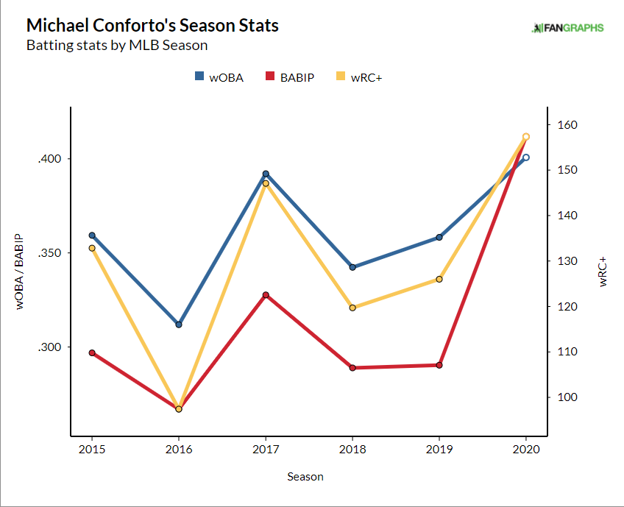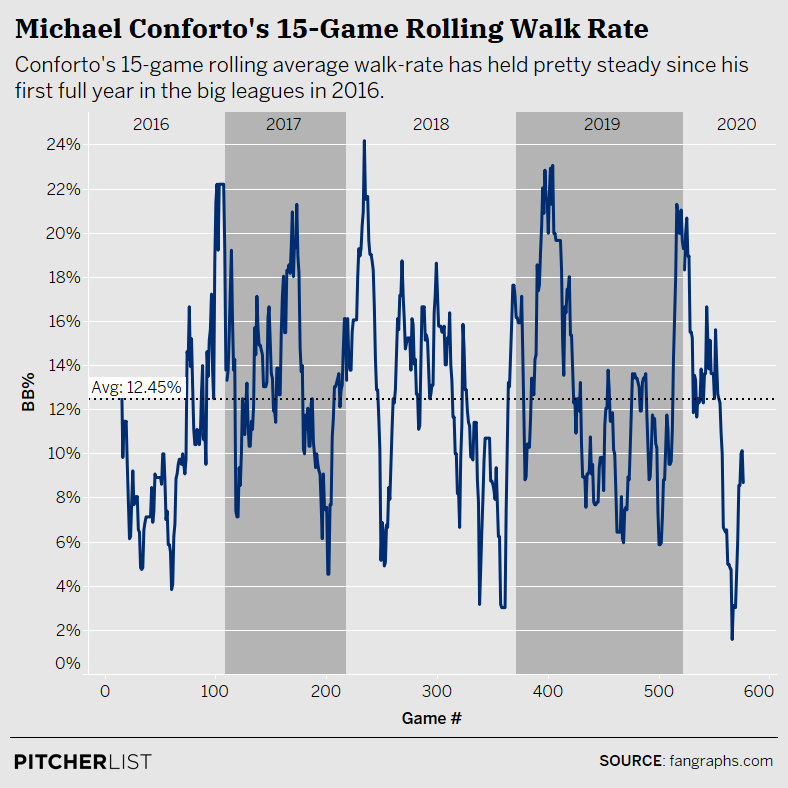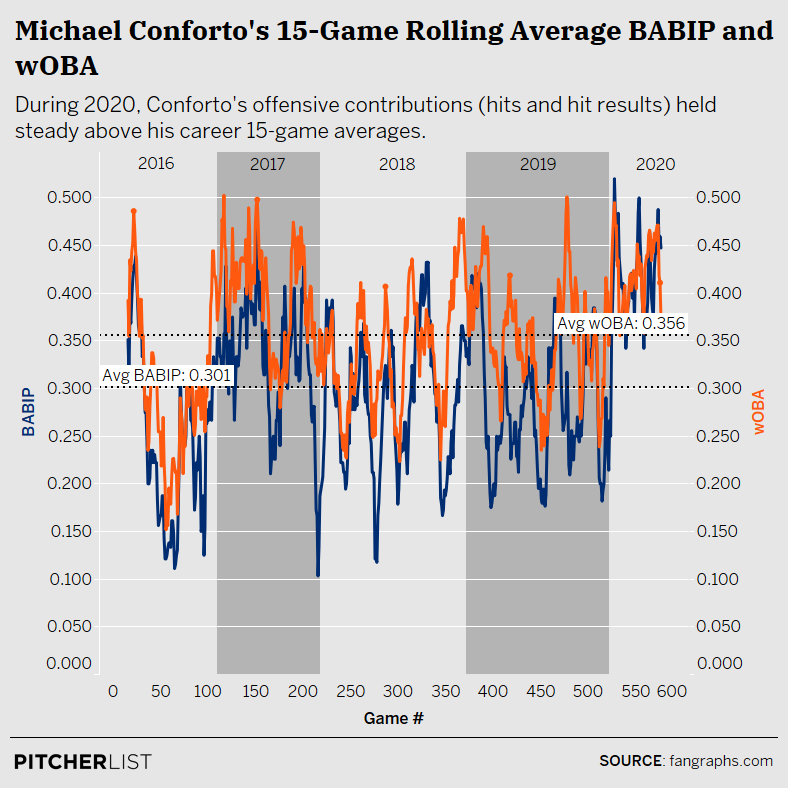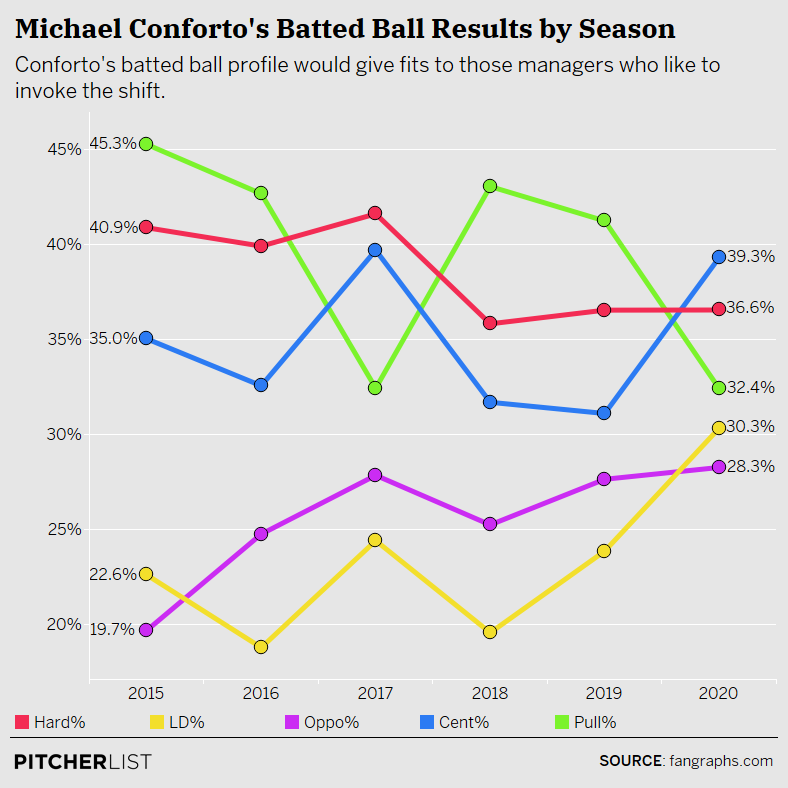Despite a disappointing 2020 season ending in not just a failure to qualify for the expanded playoffs but also a last-place finish, there was a crucial bright spot to give Mets fans cause for excitement – the long-anticipated breakout of Michael Conforto.
The former first-round pick put together what, on the surface, might appear as a classic age-27 breakout season. In the abbreviated 2020 campaign, Conforto posted a career-best 157 wRC+ (a top-15 mark in the majors) thanks to a .322/.412/.515 triple-slash line. He mashed against both lefties and righties (with a career-high .870 OPS against southpaws, 11th-best among left-handed hitters with at least 50 such plate appearances), embraced an all-fields approach en route to his first .300 season, and put up the best offensive results of his career:
| Season | BA | OBP | SLG | OPS | wOBA | wRC+ |
|---|---|---|---|---|---|---|
| 2016 | 0.22 | 0.31 | 0.414 | 0.724 | 0.312 | 97 |
| 2017 | 0.279 | 0.384 | 0.555 | 0.939 | 0.392 | 147 |
| 2018 | 0.243 | 0.35 | 0.448 | 0.798 | 0.342 | 120 |
| 2019 | 0.257 | 0.363 | 0.494 | 0.857 | 0.358 | 126 |
| 2020 | 0.322 | 0.412 | 0.515 | 0.927 | 0.401 | 157 |
For a talented, all-fields hitter who burst onto the scene during the team’s 2015 World Series run, Conforto has been consistently good, but frustratingly short of great, in the early years of his career. Mets fans could easily christen 2020 as Conforto’s ascension to the ranks of the elite, the year when he finally put everything together and made the transition from a borderline all-star to a borderline MVP candidate. Some have called for Cohen’s first priority to be locking up the right fielder to an extension before he hits the open market after the 2021 season.
And while Conforto would merit an extension based on his established track record as a solidly-above-average regular, some red flags in his 2020 profile suggest pumping the brakes on the notion that he unlocked another gear. Running a league-leading .412 BABIP over a two-month stretch, as Conforto did this season, will often lead to excellent results, but BABIP is a notably fluky metric and doesn’t indicate underlying improvement on its own. Like most hitters, his performance fluctuates considerably with his batted-ball fortunes.

The only other year Conforto maintained an above-average BABIP was 2017, when he earned his lone all-star selection. He’s remained a consistent hitter over time, with below-average zone and swing rates, leading to healthy doses of both walks and strikeouts.
Conforto’s gap-to-gap power and above-average ISO help his bat play well in a corner outfield spot, but the strong batting eye gives him a solid offensive floor even without monster home run totals. Without knowing his overall 2020 outcomes, you might actually be slightly concerned about a decline in walk rate amidst an otherwise stable plate-discipline profile.

Data Visualization by @Kollauf on Twitter
| Season | BB% | K% | Zone% | Swing% | Contact% | Z-Swing% | Z-Contact% | O-Swing% | O-Contact% |
|---|---|---|---|---|---|---|---|---|---|
| 2015 | 8.8% | 20.1% | 43.3% | 43.1% | 79.7% | 68.0% | 87.2% | 24.0% | 61.4% |
| 2016 | 10.3% | 25.6% | 43.4% | 44.1% | 78.4% | 66.2% | 88.4% | 27.2% | 59.7% |
| 2017 | 13.0% | 25.7% | 43.7% | 42.8% | 73.0% | 63.7% | 81.5% | 26.6% | 56.9% |
| 2018 | 13.2% | 24.9% | 41.5% | 43.2% | 74.6% | 65.1% | 84.0% | 27.6% | 58.7% |
| 2019 | 13.0% | 23.0% | 40.8% | 45.7% | 75.3% | 72.3% | 81.8% | 27.3% | 63.4% |
| 2020 | 10.3% | 24.5% | 40.3% | 44.2% | 75.7% | 68.6% | 86.8% | 27.7% | 57.8% |
Pitchers have attacked him in the zone less and less after his standout 2017, but his approach this season was generally in line with his career averages. In fact, the year most similar to Conforto’s 2020 season was 2016, his first year as a regular and his worst as a professional to date.
| Season | BB% | K% | Zone% | Swing% | Contact% | Z-Swing% | Z-Contact% | O-Swing% | O-Contact% | wRC+ |
|---|---|---|---|---|---|---|---|---|---|---|
| 2016 | 10.3% | 25.6% | 43.4% | 44.1% | 78.4% | 66.2% | 88.4% | 27.2% | 59.7% | 97 |
| 2020 | 10.3% | 24.5% | 40.3% | 44.2% | 75.7% | 68.6% | 86.8% | 27.7% | 57.8% | 157 |
Conforto is a notably streaky hitter, and he’s sustained stretches of good BABIP fortune and overall offensive output like this before. Even with middling exit velocity and hard-hit numbers, Statcast still had him in the top 20% of all hitters in terms of xBA and xwOBA, and well above average in BB%, Barrel%, and xSLG. It’s not like Conforto was a bad hitter this year. But in a shortened 60-game season, he had no time to run into the slumps that have plagued him in the past, and so his hot streak comprised the entire season.

So did Conforto actually do something differently to earn his .412 BABIP in 2020, or was it just a matter of timing one of his normal good stretches to align with the entire abbreviated season? Well, to borrow an old-school baseball cliche, he “used the whole field” better than he ever had before, pulling the ball less than a third of the time to go along with a career-best line drive rate.

Data Visualization by @Kollauf on Twitter
While his plate discipline metrics evoked his mediocre 2016 season, Conforto’s 2020 spray profile is almost an exact replica of his all-star 2017 season, but with a notable shift away from fly balls.
| Season | Pull% | Cent% | Oppo% | GB% | FB% | LD% | GB / FB |
|---|---|---|---|---|---|---|---|
| 2017 | 32.4% | 39.7% | 27.9% | 37.8% | 37.8% | 24.4% | 1.00 |
| 2020 | 32.4% | 39.3% | 28.3% | 41.4% | 28.3% | 30.3% | 1.46 |
More grounders and liners and fewer pulled balls are not exactly what one would associate with success for a slugging, middle-of-the-lineup corner outfielder. Pulled balls in the air are the most valuable type of batted ball, and that’s where guys like Conforto tend to do most of their damage.
But here’s where we start to see something that might be considered an intentional change of approach – pulled balls are less valuable against the shift, and non-pulled grounders and liners are especially likely to be hits in those situations with only one defender manning the left side.
In 2020, Conforto continued to face the shift (both traditional and non-traditional, as defined by FanGraphs) in little more than half of his plate appearances, about average for a left-handed hitter. With a greater emphasis on spraying the ball, he compiled a .399 wOBA against it, nearly 100 points better than he posted in any year from 2016-2019. The .399 wOBA ranked fourth-best among left-handers with at least 50 plate appearances against the shift, and it was the best mark by nearly 20 points for anyone who faced it 100 times.
| Season | PA Against Shift |
Shift wOBA |
Non-pulled LD + GB | |||
|---|---|---|---|---|---|---|
| Number | LHH Rank | % PA | BA | |||
| 2016 | 169 | 0.258 | 42 | 66 | 25% | 0.512 |
| 2017 | 184 | 0.301 | 74 | 26 | 40% | 0.459 |
| 2018 | 286 | 0.277 | 96 | 12 | 34% | 0.500 |
| 2019 | 270 | 0.305 | 90 | 14 | 33% | 0.500 |
| 2020 | 128 | 0.399 | 60 | 2 | 47% | 0.517 |
Conforto disproportionately hit his grounders and liners when he was facing the shift, with a career-high GB/FB rate of 1.97 in those at-bats. He went the other way against the shift with a ground ball or line drive 60 times, second-most among all lefties, and did so at the highest rate of his career (47%). Those 60 balls in play produced a .517 batting average and .600 slugging percentage, which is stellar but not actually unusual. Again, there’s only one infielder on the left side, which leaves a lot of room for singles. Lefty teammate Robinson Cano batted .520 with a .560 slugging percentage, while Jeff McNeil hit .551 and slugged .592 on the same type of batted balls, and none of those three are atypical results on the leaderboard.
| Rank | Player | Team | PA | AVG | SLG |
|---|---|---|---|---|---|
| 1 | Jackie Bradley Jr. | BOS | 63 | 0.508 | 0.571 |
| 2 | Michael Conforto | NYM | 60 | 0.517 | 0.600 |
| 3 | Charlie Blackmon | COL | 56 | 0.618 | 0.655 |
| 4 | Robinson Cano | NYM | 50 | 0.520 | 0.560 |
| 5 | Freddie Freeman | ATL | 49 | 0.633 | 0.755 |
| 6 | Jeff McNeil | NYM | 49 | 0.551 | 0.592 |
| 7 | Rafael Devers | BOS | 48 | 0.438 | 0.500 |
| 8 | J.P. Crawford | SEA | 46 | 0.444 | 0.489 |
| 9 | Tommy Edman | STL | 46 | 0.413 | 0.457 |
| 10 | Adam Frazier | PIT | 45 | 0.444 | 0.467 |
| 11 | Michael Brantley | HOU | 44 | 0.477 | 0.591 |
| 12 | Corey Seager | LAD | 44 | 0.591 | 0.682 |
| 13 | Juan Soto | WSH | 44 | 0.409 | 0.500 |
| 14 | Anthony Rizzo | CHC | 43 | 0.465 | 0.512 |
| 15 | Kyle Seager | SEA | 43 | 0.390 | 0.439 |
| 16 | Josh Bell | PIT | 43 | 0.465 | 0.512 |
| 17 | Alex Verdugo | BOS | 43 | 0.476 | 0.571 |
| 18 | Jake Cronenworth | SDP | 43 | 0.465 | 0.651 |
| 19 | Colin Moran | PIT | 42 | 0.429 | 0.500 |
| 20 | David Peralta | ARI | 41 | 0.537 | 0.585 |
But the volume here is key; turning any plate appearance into a roughly 50% chance at a single is a worthwhile endeavor, and particularly so when the defense is set up to minimize damage on your other batted balls to the pull side. The wOBA value of a single in 2020 was .883. Giving yourself a 50% chance at that outcome works out to a .442 wOBA, far above lefties’ league-wide wOBA of .310 against the shift. For context, Mike Trout has only bested that mark once in his career (2018). It’s a great space for Conforto, or any hitter, to occupy, and in 2020 he concentrated more of his shifted plate appearances into this bucket.
There’s an interesting game of cat-and-mouse going on. Aside from perhaps positioning the right fielder deeper, the shift can’t actually defend against the elevated rockets that become extra-base hits. On the other hand, it does take away some scorched would-be singles, and ensures outs from ground balls that might have otherwise dribbled through the standard infield alignment. Defenses are essentially trying to turn power hitters like Conforto into slap hitters, assuming they don’t have the bat control to push the ball the other way often enough to make them pay.
In 2020, Conforto gashed defenses that defended him this way by loading up on opposite-field grounders and liners. Combining that approach with a little luck resulted in posting the best season of his career. Whether defenses want to continue making that trade-off, and the extent to which he can continue executing that plan, could well turn out to be the difference between Conforto, solid player, and Conforto, the superstar Mets fans always envisioned.
(Photo by Joshua Sarner/Icon Sportswire)
